Shadow play: The innovative design of Dark House
Stepping into the Dark House, you’re immediately enveloped by an atmosphere of subtle sophistication and intricate design. Transformed by Kirsty Fletcher, Giles Lawson and Brenton Weisert from The Rexroth Mannasmann Collective, this traditional Edwardian home now stands as a testament to the artful use of dark Resene paints.
The Dark House began as a double-fronted, traditional Edwardian house. Rather than compensating for limited natural light with typical white walls and ceilings, this design amplifies the moody ambiance of Melbourne's winter. The interiors are crafted to create cosy, softly lit spaces with deep, inviting corners. In the summer, the home transforms into a cool, shady retreat from the scorching 40+ degree heat.
It's not only the colour scheme that’s new though; a renovation of the home included a new kitchen, dining and living space at the rear, updated wet areas, and additions such as a daybed, ensuite and deck that cleverly utilise the narrow side spaces for light.
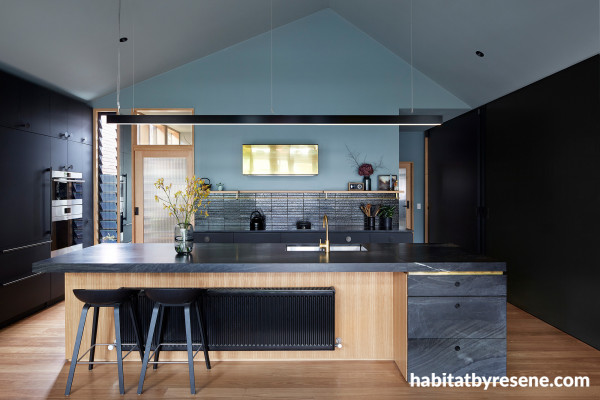
Three big sliding doors allow the adjacent living room to be separate rooms (shown above) or, when open, create open plan living, dining and kitchen. The walls and ceiling are painted in Resene Innocence and the sliding doors (left to right) are in Resene Woodsmoke, Resene Bastille and Resene Blue Bark.
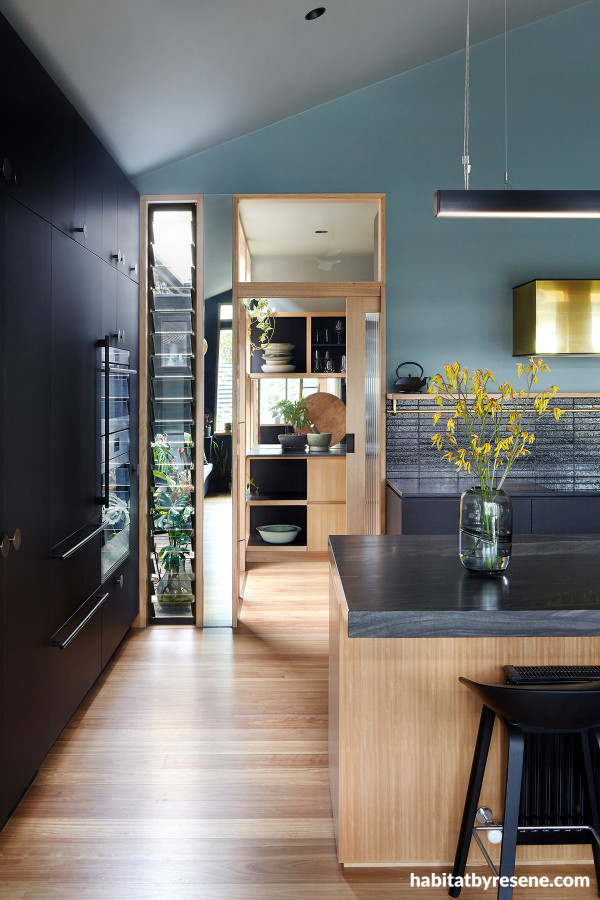
The kitchen with a view to the eastern deck.Walls and ceiling painted in Resene Innocence.
The use of ceiling and wall colours allows for both unity and separation. The homeowners can use the living areas to function as either a large, open room or intimate, discrete spaces. Physical separation is achieved through three large sliding doors that get used every day.
The wonder of Resene paints, and why Rexroth used them in this project, is that they change colour with different light. It is rare to have a project that is not about maximum windows and glass everywhere and the lower levels of direct sun allowed them to play with the mutability of colour and light. The ceiling and wall are both painted with Resene Innocence. Some days the walls and ceiling blend, rounding out the corners of the room and making the edges ill-defined. In other light, the volume is clearly visible. Similarly, the three large sliding doors morph from a black backdrop to part of the colour scheme, adding blue, green and purple highlights depending on the time of day or where you stand.
The Dark House is an exploration into the absence of light, informed by the homeowners' love of Melbourne light, Edinburgh skies and the romantic gloom reflected in much of the home's artwork.
“Our material investigations focussed on surfaces that recede and absorb light rather than bounce and reflect,” Kirsty says. “We frequently stood in tile warehouses, on the footpath outside stone yards or in Port Melbourne Paint Place with 64 samples arranged in front of us and the words of Spinal Tap guitarist, Nigel Tufnel, ringing in our ears… ‘There’s something about this that’s so black, it’s like how much more black could this be? And the answer is none, none more black.’” While Resene Innocence on the walls and ceiling are clearly not black, the colour was selected as it was a match to the “perfect” spot where black paint had sprayed over a base coat.”

The dining room is painted in Resene Innocence.
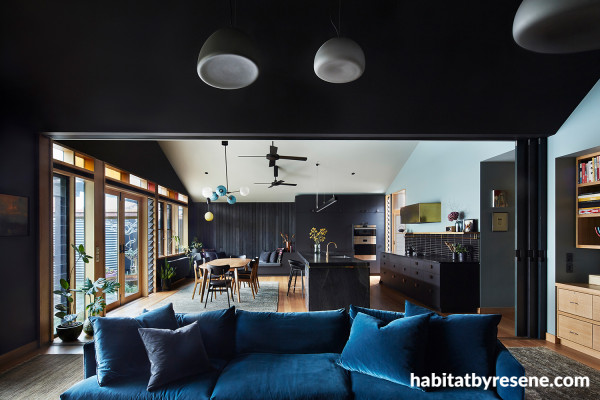
Here the sliding doors are in the open position with view of the living, dining, kitchen and daybed. The walls and ceiling are painted in Resene Innocence with sliding doors (left to right) are in Resene Woodsmoke, Resene Bastille and Resene Blue Bark.
Resene's range of colours, particularly the complex, murky tones, played a crucial role. “The perimeter walls are the blackest of black – available outside of NASA – joinery and carpets are a variety of dark textures, with warmth provided by timber floors and the undefinable blue, grey, green of Resene Innocence,” Kirsty says.
The project wasn’t without its challenges, particularly with the gabled ceiling in the dining and kitchen areas. Initial attempts to paint it black resulted in patchy finishes, forcing a reconsideration of the surfaces' colour scheme. This led to a more complex and intriguing combination of interlocking colours. The black of natural materials – charred timber and quartzite stone – and nanotech finishes – Fenix joinery – brings subtle shades in black. Using Resene Innocence on different surfaces, vertical and slanting ceilings, brings subtle and sophisticated shades of “not black”. This rethinking not only enhanced the visual interest but also focused attention on the backyard views and created an illusion of higher ceilings and blurred edges.
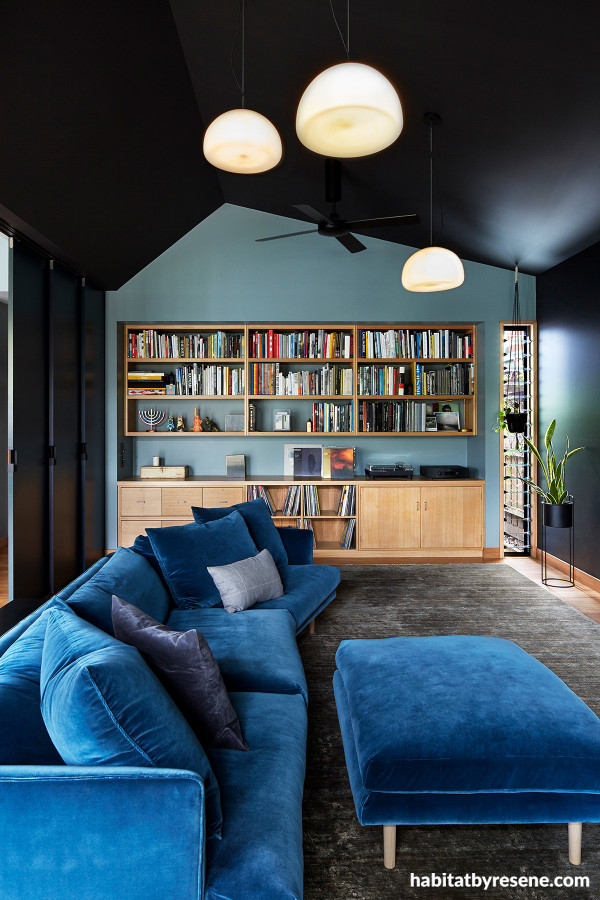
The living room can be a part of open plan living or closed off and changed into a home theatre. The walls and ceiling are painted in Resene Innocence with sliding doors (left to right) are in Resene Woodsmoke, Resene Bastille and Resene Blue Bark.
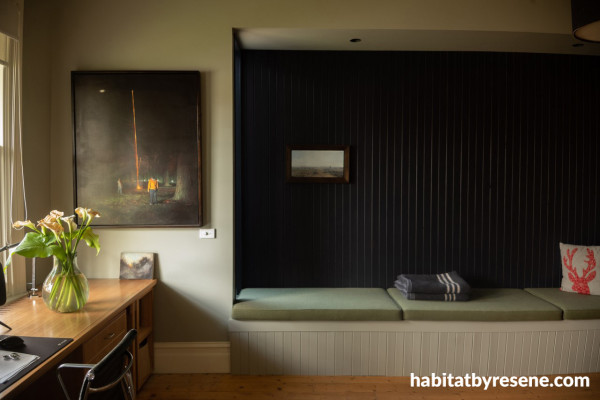
The studio in the original front part of the house is painted in a vintage 1950s paint recipe with wood panelling in Resene Bastille inspired by the misty, moody feeling of the painting.
The original intention was to use the vintage grey of the front of the house in the extension. The performance of vintage grey against the matte black was disappointing, appearing lifeless and dull. However, the overspray on the vintage grey provided a more engaging hue, leading to the discovery that Resene Innocence was the perfect colour for shadows. This unique shade added a layer of subtlety and nuance that a completely matte black interior could not achieve.
The Dark House features a variety of materials, each chosen for their light-absorbing qualities. Spaces with ample natural light, such as the wet areas, utilise flat, vintage colours matched to 1950s paint recipes. In contrast, areas with limited light benefit from shades that bring life and variation to the surfaces. Resene Innocence was fantastic for this. Resene Woodsmoke, Resene Bastille, and Resene Blue Bark are used for the sliding doors and room dividers, creating a dynamic interplay of colours that shift from black to shades of green, purple and blue.
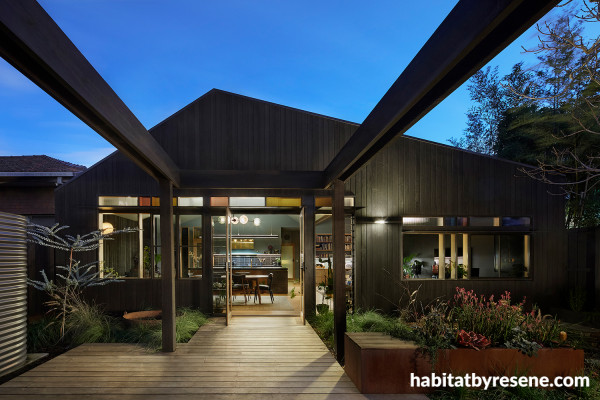
Coloured antique-style glass encourages you to look into the interior where the walls and ceiling painted in Resenecreate a deep, shadowy,cosy interior.
The Dark House is a celebration of the beauty found in shadows and depth – hues and nuances that are often missed or perhaps ‘too risky’ to try. But, through the meticulous use of colour and innovative design solutions, this traditional Edwardian home has been transformed into a sophisticated, moody retreat that responds to both the seasonal changes and the homeowners' aesthetic preferences.
The result is a home that is not only visually striking but also deeply comforting, offering a unique living experience that embraces the romance of shadow and light.
design Kirsty Fletcher, Giles Lawson and Brenton Weisert, The Rexroth Mannasmann Collective
build Forsyth Build
images Christine Francis
landscape Clea Cregan, Miniscapes
Top tip: Choose flat finishes, such as Resene SpaceCote Flat, in cocooning spaces, such as media rooms and master bedrooms, and especially where dark neutrals are planned. Flat or matt finishes help to diffuse the light giving the space a sense of cosiness and bringing out the depth of the colour’s undertone.
Published: 15 Aug 2024
Do you have a home full of wonderful Resene paint and colour? Send us some snaps by emailing [email protected].
the look
If you're stuck on what
colour to use or need colour
advice, try out the Resene
Ask a Colour Expert service.
the look
If you're stuck on what
colour to use or need colour
advice, try out the Resene
Ask a Colour Expert service.





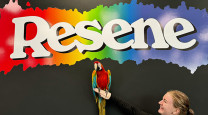
 look book
look book 





















